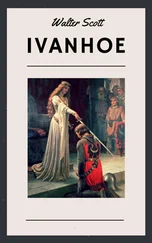Cp. ‘Loch Skene,’ a descriptive and meditative poem by Thomas Tod Stoddart, well known as poet and angler on the Borders during the third quarter of the nineteenth century:-
‘Like a pillar of Parian stone,
That in some old temple shone,
Or a slender shaft of living star,
Gleams that foam-fall from afar;
But the column is melted down below
Into a gulf of seething snow,
And the stream steals away from its whirl of hoar,
As bright and as lovely as before.’
lines 1-6. The earlier editions have a period at the end of line 5, and neither Scott himself nor Lockhart changed that punctuation. But, undoubtedly, the first sentence ends with line 11, ‘roll’d’ in the second line being a part, and not a finite verb. Mr. Rolfe is the first to punctuate the passage thus.
line 9. ‘The Abbey of Whitby, in the Archdeaconry of Cleaveland, on the coast of Yorkshire, was founded A. D. 657, in consequence of a vow of Oswy, King of Northumberland. It contained both monks and nuns of the Benedictine order; but, contrary to what was usual in such establishments, the abbess was superior to the abbot. The monastery was afterwards mined by the Danes, and rebuilded by William Percy, in the reign of the Conqueror. There were no nuns there in Henry the Eighth’s time, nor long before it. The ruins of Whitby Abbey are very magnificent.’-SCOTT.
line 10. ‘Lindisfarne, an isle on the coast of Northumberland, was called Holy Island, from the sanctity of its ancient monastery, and from its having been the episcopal seat of the see of Durham during the early ages of British Christianity. A succession of holy men held that office: but their merits were swallowed up in the superior fame of St. Cuthbert, who was sixth bishop of Durham, and who bestowed the name of his “patrimony” upon the extensive property of the see. The ruins of the monastery upon Holy Island betoken great antiquity. The arches are, in general, strictly Saxon, and the pillars which support them, short, strong, and massy. In some places, however, there are pointed windows, which indicate that the building has been repaired at a period long subsequent to the original foundation. The exterior ornaments of the building, being of a light sandy stone, have been wasted, as described in the text. Lindisfarne is not properly an island, but rather, as the Venerable Bede has termed it, a semi-isle; for, although surrounded by the sea at full tide, the ebb leaves the sands dry between it and the opposite coast of Northumberland, from which it is about three miles distant.’-SCOTT.
The monastery, of which the present ruins remain, was built, between 1093 and 1120, by Benedictine monks under the direction of William Carileph, Bishop of Durham. There were sixteen bishops in Holy Island between St. Aidan (635 A. D.) and Eardulph (875 A. D.). The Christians were dispersed after the violent inroad of the Danes in 868, and for two centuries Lindisfarne suffered apparent relapse. Lindisfarne (Gael. farne , a retreat) signifies ‘a place of retreat by the brook Lindis.’ The name Holy Island was given by Carileph’s monks, to commemorate, they said, ‘the sacred blood which had been shed by the Danes.’ See Raine’s ‘History of North Durham,’ F. R. Wilson’s ‘Churches of Lindisfarne,’ and Mr. Keeling’s ‘Lindisfarne, or Holy Island: its History and Associations.’
line 17. Cp. Coleridge’s ‘Ancient Mariner’:-
‘The fair breeze blew, the white foam flew,
The farrow followed free.’
line 20. For Saint Hilda, see below, note on line 244.
Stanza II. line 33. sea-dog, the seal.
line 36. still. Cp. above, I. 430.
line 44. A Novice is one under probation for a term extending to at least a year, and it may extend to two or three years, after which vows are either taken or declined.
Stanza IV. line 70. Benedictine school. St. Benedict founded his order-sometimes, because of their dark garb, called Black Friars-in the beginning of the sixth century. Benedict of Aniana, in the eighth century, reformed the discipline of the order.
line 74. Cp. Chaucer’s Prioress in the Prologue:-
‘And sikerly sche was of gret disport,
And ful plesaunt, and amyable of port.’
Stanza V. line 90. Cp. Spenser’s Una, ‘Faery Queene,’ I. iv:-
‘A lovely Ladie rode him faire beside.
* * *
As one that inly mournd, so was she sad,
And heavie sat upon her palfrey slow.’
Stanza VI. With this ‘brown study,’ cp. Wordsworth’s ‘Reverie of Poor Susan.’
Stanza. VII. line 114. Reference to the lion of ‘Faery Queene,’ I. iii:-
‘Forsaken Truth long seekes her love,
And makes the Lyon mylde.’
line 124. bowl and knife. Poisoning and stabbing.
Stanza VIII. Monk-Wearmouth. A monastery, founded here in 674 A. D., was destroyed by the Danes in the ninth century, and restored after the Norman Conquest. For Tynemouth, see below, 371, Seaton-Delaval, the seat of the Delavals, who by marriage came into possession of Ford Castle. Widderington. It was a ‘squyar off Northombarlonde, Ric. Wytharynton,’ that showed notable valour and persistent endurance at Chevy Chase:-
‘For Wetharryngton my harte was wo,
That ever he slayne shulde be;
For when both his leggis wear hewyne in te,
He knyled and fought on hys kne.’
Butler, fully appreciating this doughty champion, uses him in a descriptive illustration, ‘Hudibras,’ I. iii. 95:-
‘As Widdrington, in doleful dumps,
Is said to fight upon his stumps.’
Widderington Castle, with the exception of one tower, was destroyed by fire. Warkworth Castleis about a mile from the mouth of the Alne, and is the seat of the Duke of Northumberland. Bamborough, the finest specimen of a feudal castle in the north of England, is said to have been founded by King Ida about the middle of the sixth century. Lord Crewe, Bishop of Durham, purchased the Bamborough estates between 1709 and 1720, and left them for charitable purposes. This charity maintains, inter alia , a national school in the village of Bamborough, and an officer to fire a cannon from the dangerous rocks every fifteen minutes in foggy weather, besides providing for the education of thirty girls within the castle walls.
Stanza IX. line 164. battled. See above, I. 4.
Stanza X. line 173. Pointed or Gothic architecture came in towards the end of the twelfth century.
Stanza XII. line 215. Suppose we= Let us suppose. This is an Elizabethanism. Cp. Macbeth, i. I. 10:-
‘Hover through the fog and filthy air,’
where hover = hover we.
Stanza XIII. line 234. Scott quotes from ‘A True Account,’ circulated at Whitby, concerning the consequences of a boar-hunt on Eskdale-side, belonging to the Abbot of Whitby. The boar, being hard pressed, made for a hermitage and died just within the door. Coming up, the three leaders-William de Bruce, Lord of Uglebarnby, Ralph de Percy, Lord of Smeaton, and a freeholder named Allatson-in their disappointment and wrath set upon the hermit, whom they fatally wounded. When the abbot afterwards came to the dying hermit, and told him his assailants would suffer extreme penalty for their ruthless conduct, the hermit asked the gentlemen to be sent for, and said he would pardon them on certain conditions. ‘The gentlemen being present bade him save their lives.-Then said the hermit, “You and yours shall hold your lands of the Abbot of Whitby, and his successors, in this manner: That, upon Ascension-day, you, or some of you, shall come to the wood of the Stray-heads, which is in Eskdale-side, the same day at sun-rising, and there shall the abbot’s officer blow his horn, to the intent that you may know where to find him; and he shall deliver unto you, William de Bruce, ten stakes, eleven strout stowers, and eleven yethers, to be cut by you, or some of you, with a knife of one penny price: and you, Ralph de Percy, shall take twenty-one of each sort, to be cut in the same manner; and you, Allatson, shall take nine of each sort, to be cut as aforesaid, and to be taken on your backs and carried to the town of Whitby, and to be there before nine of the clock the same day before mentioned. At the same hour of nine of the clock, if it be full sea, your labour and service shall cease; and if low water, each of you shall set your stakes to the brim, each stake one yard from the other, and so yether them on each side with your yethers; and so stake on each side with your strout stowers, that they may stand three tides, without removing by the force thereof. Each of you shall do, make, and execute the said service, at that very hour, every year, except it be fall sea at that hour; but when it shall so fall out, this service shall cease. You shall faithfully do this, in remembrance that you did most cruelly slay me; and that you may the better call to God for mercy, repent unfeignedly of your sins, and do good works. The officer of Eskdale-side shall blow, Out on you! Out on you! Out on you! for this heinous crime. If you, or your successors, shall refuse this service, so long as it shall not be full sea at the aforesaid hour, you or yours shall forfeit your lands to the Abbot of Whitby, or his successors. This I entreat, and earnestly beg, that you may have lives and goods preserved for this service: and I request of you to promise, by your parts in Heaven, that it shall be done by you and your successors, as is aforesaid requested; and I will confirm it by the faith of an honest man.”-Then the hermit said, “My soul longeth for the Lord: and I do as freely forgive these men my death, as Christ forgave the thieves on the cross.” And, in the presence of the abbot and the rest, he said moreover these words: “ In manus tuos, Domine, commendo spiritum meum, a vinculis enim mortis redemisti me, Domine veritatis, Amen .”-So he yielded up the ghost the eighth day of December, anno Domini 1159, whose soul God have mercy upon. Amen.
Читать дальше






